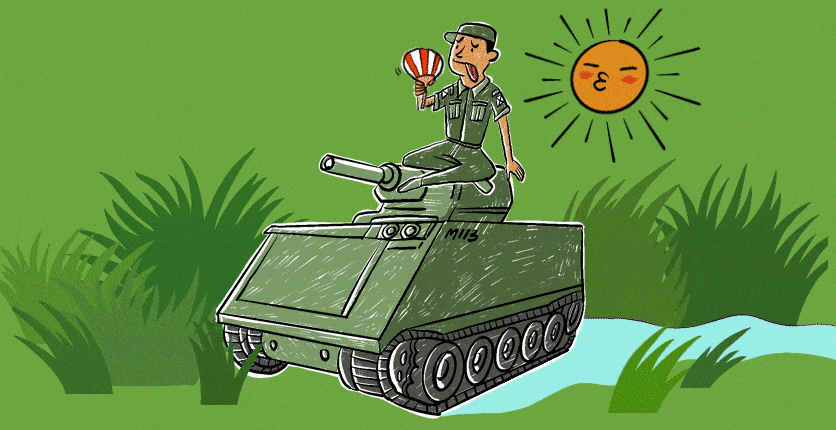I must admit that old timers like me relish comparing our National Service days with those of today’s NSFs and flexing about how we were more garang and had to endure more hardship.
But there is one thing that today’s servicemen have it worse – the heat.
I’m glad that the SAF has been taking steps to address the (excuse the pun) hot topic of preventing heat injuries. According to a May 2023 MINDEF release, “all soldiers undergo heat acclimatisation as soon as they are enlisted in Basic Military Training”.
I know what you’re thinking, but no. Recruits these days don’t get to use the sauna as part of their training.
Rather, “acclimatisation” involves ensuring that servicemen receive appropriate build-up training, adequate rest and hydration. They are also issued with isotonic gel during road marches to boost hydration and energy.
I’ve also discovered that the SAF has been using ingestible thermometer pills that measure the body temperatures of selected soldiers.
I’m assuming these tiny thermometers are meant for single use, because it would be a bitter pill to swallow if soldiers have to reuse them in the name of sustainability.
Then again, maybe doing so will really drive home the message that global warming is a really, ahem, crappy situation.
Perhaps we aren’t all that far from a future in which we can simply pop a pill that regulates our body temperature accordingly. Such a product would be revolutionary. In fact, I reckon it might even put air conditioning manufacturers out of business.
I’m certainly looking forward to such a reality, because the constant use of air conditioning at home to beat the heat is becoming too expensive for me.
You see, my utility bill for last month was a whopping $500.
Perplexed by how this figure is more than twice that of the previous month, I called up my energy provider and asked if they had made a mistake.
I must say the customer service representative was an immaculate professional because she patiently explained to me that the bill was exceptionally high because the bills for the previous two months were based on estimates and not on an actual meter reading.
I must also say that this is exactly why I’m not cut out for jobs that require me to face customers.
Because if someone asked me why his or her utility bill is so high, my instinctive reply would be one typical of any grouchy encik:
“Eh, are you goondu or what? Your bill is so high because you used a lot of electricity, lah!”
Look, climate change is real. Global temperatures have been steadily rising because of this. In fact, researchers have forecast that, in the worst-case scenario, daily average temperatures in Singapore could spike from the current 27.9 deg C to 32.9 deg C by the end of the century.
Singapore has it especially bad because of the urban heat island effect, which refers to the phenomenon of urban structures such as buildings and roads trapping heat in the day. This heat is later released at night, which explains why our nights can get unbearably hot even though the sun is nowhere to be seen.
More buildings should be like SAFRA Choa Chu Kang, where a Green Boulevard is woven into the clubhouse, sheltering and guiding users, acting as a green spine which interlaced with nature. Yes, urban greeneries can reduce ambient temperature by 1 to 2 degrees Celsius, so we should think about converting more top-level car parks to garden spaces.
On the topic of trapped heat, I must say that my fellow armoured infantry comrades probably understand this best.
Why? Because contrary to popular belief, we don’t have it easy compared to our infantry counterparts – we do not cruise around in air-conditioned vehicles.
The ancient M113 Ultra that I was trained in was essentially an oven within which we were slowly baked alive. There was no air conditioning in the vehicle, only a tiny fan that was as powerful as a mother tenderly blowing on the wound of her child.
Thankfully, the hatches on the top of the vehicle were almost always open during training, and this provided us with some ventilation.
But I still remember the rare occasions when CAT 1 was raised, and we had to stay put in our vehicles with the hatches battened down as the storm raged on.
The smell within the vehicle was one to remember. Just like a magnificent Beaujolais from France’s famed Burgundy region, the aromatic notes of the air within the M113 were intriguingly complex. It had invigorating top notes of grass and mud, refreshing middle notes of insect repellant and gunpowder, and base notes of human sweat and automotive grease.
That was the first time in my life I knew that humans could have wok hei too.
The M113’s successor, the Bionix, wasn’t any better. But I’m glad to hear that the Hunter, the SAF’s latest Armoured Fighting Vehicle, is fully air-conditioned.
That’s amazing!
Some old-timers (not me ah) say that strawberries don’t last long if they aren’t refrigerated. However, I think arriving in combat-ready condition to the fighting ground is half the battle won. The Hunter is also equipped with an automatic target detection and tracking system, enhancing the crew’s ability to more quickly and effectively detect and engage targets, as well as a Laser Warning System which provides early warning to the crew when they are being targeted by aggressors.
Nope, we didn’t buy it overseas, in fact, it was jointly developed by the DSTA in collaboration with the Singapore Army and ST Engineering.
Steady lah SAF! Can I call this 5th Generation SAF?
LOL Mondays is an ongoing series of slice-of-life stories from freelance writer and NSman Alywin Chew. Look out for the humorous tales which will be posted every first Monday of the month, to help you drive away your Monday blues!
Want more fun articles like this, and other lifestyle content right in your inbox? Download the new SAFRA mobile app and opt in for the eNSman Newsletter – you don’t need to be a SAFRA member to subscribe – and never miss another story!







